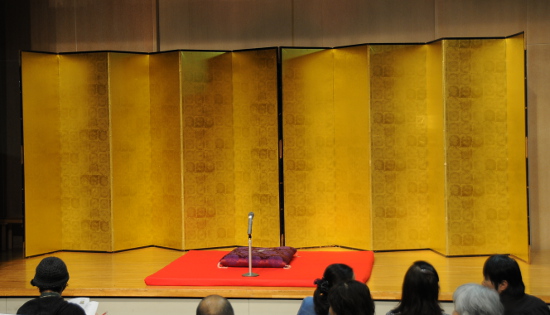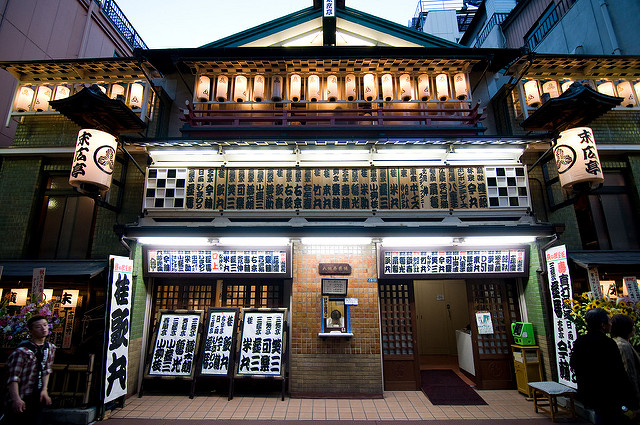When it comes to Japanese performing arts, one first thinks of Noh and Kabuki, two very old forms of theater. Elaborate costumes are used, the masks are stunning, the movements highly stylised, and the stories told are often moral and serious.
And then there is rakugo, and it’s none of these. To be fair, rakugo is not so much a theatrical performance, but a storytelling. A single performer – rakugoka – sits on a stage, with nothing but a cushion and a folding screen (and sometimes a little table) as stage design. He – yes, mostly they are men – has nothing by way of props but a folding fan and a tenugui, a small Japanese towel. But this is all he needs to tell his story: gestures and body movements, a change of pitch in his voice, or a slightly changed posture will do – the rest lies in the viewer’s imagination.
 Rakugo goes back to Buddhist monks of the 10th century, who interjected little, often humorous stories to their sermons to make them better understandable for the lay people. The stories evolved to a kind of monologue that people told among themselves, and especially the daimyo of the Edo period were the patrons of this kind of storytelling. With the rise of the rich merchant class, however, rakugo as an art form finally spread to the common people, and by the end of the 18th century, professional rakugoka had emerged, who rented rooms – yose – for their performances. Finally, theaters especially for rakugo were set up as well.
Rakugo goes back to Buddhist monks of the 10th century, who interjected little, often humorous stories to their sermons to make them better understandable for the lay people. The stories evolved to a kind of monologue that people told among themselves, and especially the daimyo of the Edo period were the patrons of this kind of storytelling. With the rise of the rich merchant class, however, rakugo as an art form finally spread to the common people, and by the end of the 18th century, professional rakugoka had emerged, who rented rooms – yose – for their performances. Finally, theaters especially for rakugo were set up as well.

Many of the stories performed date back to the beginnings of rakugo as it is known today, some 400 years ago. The traditional canon comprises several hundred pieces of various lengths, but there are some modern rakugoka who write and perform their own stories. A large part of the attractiveness of the stories is the fact that they are dialogues between different stereotypical people, and that these dialogues sound very natural. Some of the stereotypes employed are: The sexy young girl, the authority figure, the dumb vs. the smart person, the cunning and lying figure, etc. They are pitched against each other in the performance, and at the end, there is an ochi (literally meaning fall) which brings the main story to an unexpected, funny end.
Before the main story starts, however, the rakugoka starts with an anecdote called makura (literally: pillow) to lead the viewer into the main story. Watch this English performance of the famous story “The Cat’s Bowl”; the first half of the video is the makura (which may or may not be true recollections of the performer), and the main story starts at about 5:20.
Today, there are about 700 professional rakugoka in Japan, about 30 of them women, divided between the two traditions of Edo/Tokyo and Osaka. Even today, the way to become a rakugoka is by receiving direct instruction from a master performer. Just like in the old days, the student – deshi – will move into the master’s house and essentially run his household. During the 2 – 4 years of training, the master in turn is fully responsible for the student, including in financial matters.
The training in the art itself is done verbally only, and while audio and video are now allowed, books or other notes are still frowned upon. After all, this is an oral tradition! The master tells the story, and the student imitates. Only when the student has fully memorised the story, will he get permission to perform it – this particular story only! The three ranks of rakugoka are zenza, futatsume and shinuchi; the final rank allows a rakugoka to train students of his own.
Rakugo is still quite popular, both on TV and live. The setup of the performance can almost be called intimate, and the Japanese take advantage of the opportunity to let their hair hang down in public.
